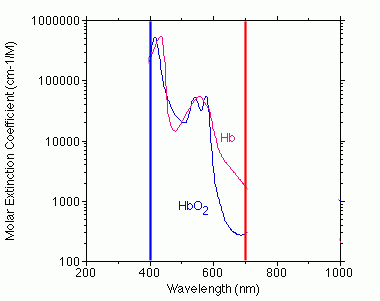
The blue appearance of veins under unpigmented skin is a commonplace observation, to the extent that it has become standard coding in anatomy diagrams to colour arteries red and veins blue:

But that pale blue colour is actually a bit of a puzzle.
Blood gets its colour from the haemoglobin contained in the red blood cells. The haemoglobin changes colour depending on whether it’s bound to oxygen or not. So first of all we want to know what colour venous blood is.
I’m indebted to Scott Prahl, of the Oregon Medical Laser Center, for permission to reproduce this graph of the absorption spectra of haemoglobin bound to oxygen (HbO2) and haemoglobin without attached oxygen (Hb):

The lower the graph dips, the less the absorption, and so the more light at that wavelength the haemoglobin will reflect. And notice there’s a logarithmic vertical scale—those dips mean a big proportional change in light absorption. Below, I’ve edited the graph to show just the visual wavelengths, stretching from 400nm (violet) on the left to 700nm (red) on the right:

HbO2 is absorbing between a hundred and a thousand times more short-wavelength blue than long-wavelength red light. So it’s going to be strongly red in colour—hence the lurid colour of the oxygenated blood that comes out of a cut artery. Without oxygen, Hb absorbs more red light than HbO2 by a factor of ten or so. But it still absorbs ten to a hundred times more light at the blue end of the spectrum than the red—so venous blood, which contains a mix of oxygenated and deoxygenated haemoglobin, is also going to be red in colour, albeit a darker and less saturated red than arterial blood. And we confirm that every time we take a venous blood sample—what flows into the syringe is anything from dark red to deep purple-red; certainly not blue.
So it’s not venous blood that causes the blue colour. Is it the vein wall?
Veins are thin-walled structures. If removed from the body and inflated with saline, they appear translucent pink. When they’re filled with blood, the blood inside shows through, rendered a little paler and pinker by the wall of the vein. Here is a view of a major artery and vein, exposed during surgery (SMV = superior mesenteric vein; SMA = superior mesenteric artery):

A vein full of blood evidently doesn’t look blue, either.
So it must be something to do with the overlying skin and subcutaneous tissues. Keinle et al. (116 KB pdf) investigated this in the journal Applied Optics, back in 1996. To slightly simplify their argument, what they found was as follows.
Unpigmented skin and tissues scatter both blue and red wavelengths back to the eye, with a preponderance of red that makes flesh look pink. But, crucially, red light travels farther into the tissue before bouncing back out again. The blue wavelengths show us the very superficial layers; the red wavelengths probe deeper structures.
 And we know that veins, with their translucent walls, bounce back a small amount of light from the dark blood inside, but with red still predominant.
And we know that veins, with their translucent walls, bounce back a small amount of light from the dark blood inside, but with red still predominant. But what happens if we put a vein inside the tissues, positioning it deeper than the blue wavelengths typically penetrate, but within range of the red? The superficial tissues scatter away the blue light before it reaches the vein. The vein absorbs more red light than the tissues would have done. Blue predominates!
But what happens if we put a vein inside the tissues, positioning it deeper than the blue wavelengths typically penetrate, but within range of the red? The superficial tissues scatter away the blue light before it reaches the vein. The vein absorbs more red light than the tissues would have done. Blue predominates! And that’s why most visible veins look blue. If they lie any deeper in the tissues, neither red nor blue light reaches them, and they are invisible. And it’s unusual for them to be so superficially placed that blue wavelengths can reach them—that requires the sort of delicate, thin skin we sometimes find in premature babies and the very old. Those of us whose job involves inserting IV cannulae into veins know from experience that a red-looking vein is thin-walled and lying very close to the surface.
And that’s why most visible veins look blue. If they lie any deeper in the tissues, neither red nor blue light reaches them, and they are invisible. And it’s unusual for them to be so superficially placed that blue wavelengths can reach them—that requires the sort of delicate, thin skin we sometimes find in premature babies and the very old. Those of us whose job involves inserting IV cannulae into veins know from experience that a red-looking vein is thin-walled and lying very close to the surface.
So those blue veins on the back of your hand represent a remarkable conspiracy between optics and anatomy.
or
